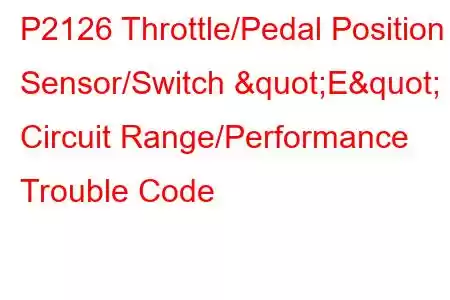P2126 Throttle Position Sensor E Circuit Range/Performance
OBD-II Trouble Code Technical Description
Throttle/Pedal Position Sensor/Switch "E" Circuit Range/Performance
What does that mean?
This diagnostic trouble code (DTC) is a generic powertrain code, which means that it applies to OBD-II equipped vehicles. Although generic, the specific repair steps may vary depending on make/model.
The Throttle position sensor is a potentiometer that measures the amount of throttle opening. As the throttle is opened, the reading (measured in volts) goes up.
The powertrain control module (PCM) is the main computer controlling the vehicle and it supplies a 5 Volt reference signal to the throttle position sensor (TPS) and usually a ground also. A general measurement is: at idle = .5 Volts; full throttle = 4.5 Volts. If the PCM detects that the throttle angle is greater or less than it should be for a specific RPM, it will set this code. The "E" refers to a particular circuit, sensor, or area of a particular circuit.
Potential Symptoms
Symptoms of a P2126 trouble code could include:
Malfunction Indicator Lamp (MIL) illumination (Check Engine Light or Service Engine Soon light) Intermittent stumble on acceleration or deceleration Blows black smoke on acceleration No startCauses
A code P2126 may mean that one or more of the following has happened:
TPS has intermittent open or short internally Harness is rubbing and causing an open or short in the wiring Bad connection at the TPS Bad PCM (less likely) Water or Dorrosion in connector or sensorPossible Solutions
1. If you have access to a scan tool, see what the idle and WOT (wide open throttle) readings are for the TPS. Check if they're close to the specifications mentioned above. If not, then replace the TPS and re-check.
2. Check for an intermittent open or short in the TPS signal. To do that, you can't use a scan tool. You'll need an oscilliscope. The reason is because scan tools take samplings of many different readings over just one or two data lines and can miss an intermittent drop out. Hook up your oscilliscope and watch the signal. It should sweep up and down smoothly with no drop outs or spikes.
3. If no problems were noticed, perform a wiggle test. Do this by wiggling the connector and harness while watching the pattern. Does it drop out? If so, replace TPS and re-check.
4. If you have no TPS signal, check for 5 Volt reference at the connector. If it's present, check the ground circuit for open or shorts.
5. Make sure the signal circuit isn't 12V. It should never have battery voltage. If it does, trace circuit for short to voltage and repair.
6. Look for any water in the connector and replace TPS as necessary.
Read: 28


